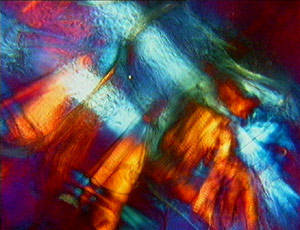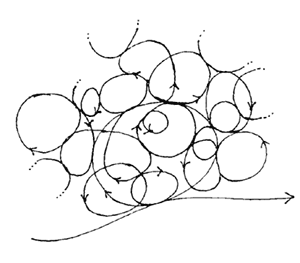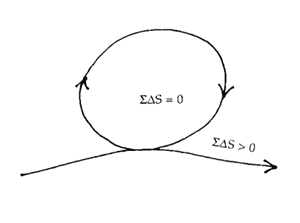Living energies mini-series
The secret of life is not to be found in the molecular nuts and bolts in living organisms. Instead, it may be in how organisms use energy. This mini-series will hint at what lies in store, which gives concrete meanings to renewable living energy and sustainability.
Complexity is linked to productivity and sustainability. Dr. Mae-Wan Ho explains.
The organism is like an ecosystem in many respects. It is highly complex. And like the ecosystems, it is useful to look at its complexity is in terms of organised, nested heterogeneity. The simplest kind of nested heterogeneity is a fractal structure – with fractional dimensions in between the usual 1, 2 or 3 - that is similar on many, if not every scale. Fractal geometry offers a ready mathematical description of the simplest kind of organised complexity.
Some years ago, I showed how such a system is optimised for storing and mobilising energy. In other words, it captures and stores useful coherent energy, and mobilises it most efficiently and rapidly. The rigorous arguments [1-3] involves formal thermodynamics, a discipline that deals with energy transformation; but can be stated in a much more intuitive form [4], which I shall reproduce here.
'Sustainability' has become a buzzword, but it is difficult to say exactly what it means. Rather than indulge in getting a correct definition, I want to show that there is a lot we can learn about sustainability by studying how organisms sustain themselves, or keep alive.
The pre-requisite for keeping away from thermodynamic equilibrium – death by another name – is the ability to capture energy and material from the environment to develop, to grow and to recreate oneself from moment to moment during one's life time. The organism not only sustains itself dynamically, it also reproduces future generations, which is part and parcel of sustainability.
An organism needs, first of all, physical barriers that separate inside from the outside, though not completely. It also needs a dynamic structure that enables it to store as much energy and material as possible, and to use the energy and material most efficiently and rapidly, with the least amount of waste and dissipation. Dissipation means the loss of useful energy from the system.
The organism has solved those problems over billions of years of evolution. It has an obviously nested physical structure. Our body is enclosed and protected by a rather tough skin, but we can exchange energy and material with the outside, as we need to, we eat, breathe and excrete. Within the body, there are organs, tissues and cells, each with a certain degree of autonomy and closure. Within the cells there are numerous intracellular compartments that operate more or less autonomously from the rest of the cell. And within each compartment, there are molecular complexes doing different things, such as transcribing genes, making proteins and extracting energy from our food. And all those compartments are perfectly orchestrated.
The organism is indeed so perfectly coordinated that an actively mobile animal typically appears liquid crystalline under the polarising microscope, due to the coherent motions of all its molecules [1] (see Fig. 1). This perfect coordination depends to a large extent on how energy is mobilised within the organism.
It turns out that energy is mobilised in cycles, which can be thought of as dynamic boxes, and they come in all sizes, from the very fast to the very slow, from the global to the most local. Biologists have long puzzled over why biological activities are predominantly rhythmic or cyclic, and much effort has gone into identifying the centre of control, and more recently to identifying master genes that control biological rhythms, all to no avail.

Figure 1. Inside the liquid crystalline brine-shrimp (200X).
The organism is full of cycles possibly because cycles make thermodynamic sense. Cycles involve perpetual returns to the same states, they give dynamic stability as well as autonomy to the organism. Cycles also enable the activities to be coupled, or linked together, so that those yielding energy can transfer the energy directly to those requiring energy, and the direction can be reversed when the need arises. These symmetrical, reciprocal relationships are most important for sustaining the system. That's how our metabolism and physiology is organised: closing the cycle and linking up.
I have drawn a diagram to represent the nested cycles that span all space-time scales, the totality of which make up the life cycle of the organism (Fig. 2). I have also proposed that the life cycle has a self-similar fractal structure, so if you magnify each cycle, you will see that it has smaller cycles within, looking much the same as the whole.
The system effectively stores and mobilises energy over all space-times that are coupled together, so energy can get from any space-time compartment to every other, from the local to the global and vice versa. This complex dynamical structure is the secret of how the system can sustain itself as a whole.

Figure 2. The life cycle of the organism consists of a
self-similar fractal structure of cycles turning within cycles
In the ideal, the system is always tending towards a dynamic balance, expressed in another diagram (Fig. 3). The simple equation, S DS = 0, inside the cycle, says there is an overall internal balance and compensation of energy so that the system organisation is maintained, and the necessary dissipation (entropy, S, made up of degraded, incoherent energy) is exported to the outside, S DS > 0. But that's the abstract ideal. In practice, dissipation within the system goes to a minimum, not quite zero. In other words, the system does grow old and eventually die, but only very slowly.

Figure 3. The organism consists of internally balanced
cyclic processes coupled to energy flow.
Minimum dissipation means, in one sense, that energy (as well as material) going into the system is used many times over before it is exported to the outside. Intuitively, one can see that the more complex the dynamical structure, the more cycles there are, the longer the energy remains in the system, and the least amount is dissipated. In other words, increase in space-time differentiation leads to increase in the energy that can be stored in the system.
Can we look at a sustainable ecosystem, and ultimately the sustainable global ecosystem in the same way? I have suggested that we can some years ago [5].
Since then, evidence has been accumulating in ecology that productivity – rate of production of biomass – generally, though not always goes up with biodiversity (see "Energy, productivity & biodiversity", this series), although the precise causal relationship is still uncertain.
In my theory based on energy storage, productivity and the complexity of space-time differentiation – a correlate of biodiversity - are completely linked: the more complex the space-time differentiation, the greater the energy stored, which is productivity by another name.
It also explains why greater energy input doesn't necessarily increase productivity: if the energy is supplied at a rate greater than the space-time differentiation of the system can assimilate, then no further increase in productivity can occur. An over-abundant supply of energy can indeed unbalance the system, leading to a decrease in space-time differentiation, and hence a fall in productivity (hence the unimodal relationship between diversity and productivity, see "Energy, productivity & biodiversity").
Evidence linking productivity and biodiversity has also emerged in agriculture. David Tilman and his colleagues in the University of Minneapolis in the United States have recently produced the best experimental evidence that biodiverse fields are more productive [6-7], although the precise explanation is still hotly debated [8]. Other ecologists are also rediscovering how it is the symbiotic reciprocal relationships, rather than competition, which sustain the ecosystem as a whole [9]. It is a case of closing circles and joining up to build a more complex space-time differentiation in the ecosystem.
Sustainable farming across the world relies on cultivating a diversity of crops and livestock to maximise internal input, which effectively closes up cycles and maximises the nested, space-time structure of the system. This wisdom has informed traditional indigenous farming systems for millennia, in marked contrast to the high external input monoculture of industrial farming, which breaks cycles and destroys space-time differentiation, and is proving unsustainable in many respects.
These findings also explode the myth of constant 'carrying capacity' that have been used to estimate how many people a piece of land, or the earth as a whole, can support.
In recent years, African farmers all along the edge of the Sahara, in Nigeria, Niger, Senegal, Burkina Faso and Kenya, have been working miracles [10], pushing back the desert, and turning the hills green, simply by integrating crops and livestock to enhance nutrient recycling, by mix-cropping to increase system diversity, and reintroducing traditional water-conservation methods to overcome drought. Yields of many crops have tripled and doubled, keeping well ahead of population increases.
In fact, high local population densities, far from being a liability, are actually essential for providing the necessary labour to work the land properly, digging terraces and collecting water in ponds for irrigation, and to control weeds, tend fields, feed the animals and spread manure. In some areas, the population density or carrying capacity went up fivefold, but the land is far more productive than ever before.
Organisms are the most energy-efficient 'machines' by far, a point lost on policy-makers bent on increasing efficiency by getting rid of workers and introducing other unsustainable 'labour-saving' measures. It is high time policy-makers learn thermodynamics.
Article first published 30/01/04
Comments are now closed for this article